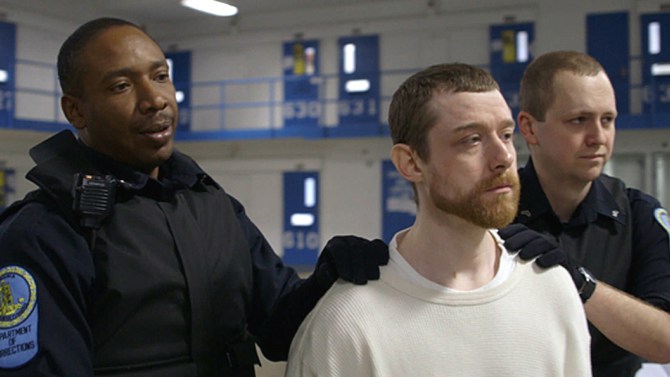
Solitary film follows inmates and officers at Virginia’s Red Onion prison
(10-6-16) I’m excited to be participating tomorrow (Friday) in a panel discussion about solitary confinement in America’s jails and prisons.
Entitled: “Unlocking Prison: A Case Study,” the discussion will happen at the National Press Club (13th Floor) from 11:15 AM – 12:45 PM, as part of Double Exposure, the Investigative Film Festival and Symposium being held in Washington D.C.
This is the second year for the three day festival that begins today (Thursday) and ends Saturday, October 8, 2016.
The Double Exposure festival is unique because it combines investigative journalism with the visual arts by featuring the work of investigative journalists who work on films and in other visual forms. The line up of films this year is truly first-rate. They range from an investigation of elephant hunting for ivory to a profile of the banker who leaked documents to WikiLeaks exposing secret bank accounts and tax havens to Wall Street shenanigans involving pyramid schemes,
Our panel discussion is being held in conjunction with the showing of a dramatic documentary called SOLITARY, a film made by Kristi Jacobson who spent a year filming the lives of guards and inmates at Red Onion State Prison in southern Virginia. Here is a snippet about the film from a Nick Schager review in Variety.
There’s little hope, but considerable insight, found in “Solitary,” Kristi Jacobson’s documentary about Wise County, Virginia’s Red Onion State Prison, a supermax facility where convicts are holed up for 23 hours a day in separate 8′-by-10′ cells. Shot over the course of a year, the film presents an unfiltered insider’s view of their colorless day-to-days, which are largely spent trying to stave off madness…
“Solitary” concentrates on a handful of Red Onion’s inhabitants, all of them locked away for serious crimes and resigned to spending the rest of their lives behind bars. They are, by and large, well-spoken and introspective, the latter born from the fact that their time is mostly spent by themselves, with only minimal contact with guards — and chats with other inmates through cells’ air vents — to mitigate their crushing seclusion.
Jacobson will be showing SOLITARY on Saturday, October 8th, at 5:30 at the festival. You can purchase tickets here.
I will be discussing solitary confinement the day before at the press club with Kristi Jacobson and investigative journalist Lisa Armstrong. We will reconvene for another panel discussion after Saturday night’s showing of her powerful and insightful film.
While I intend to speak about the practice of putting persons with mental illnesses into solitary confinement, I’ll also discuss my book, The Hot House: Life Inside Leavenworth Prison. It describes a year that I spent inside a maximum security penitentiary as a reporter. The organizers were especially interested in learning about Thomas Silverstein.
I am the only reporter to have interviewed Silverstein in person since 1983 when he was put under what the federal Bureau of Prisons called “no human contact” status, the harshest allowed. At the time there was no death penalty for prisoners who murdered a correctional officer, so the BOP created that unofficial category exclusively for him. He has been held in continuous solitary confinement longer than any other American prisoner — 33 years. Much of time, he was held in a cell where the lights were on continuously in the prison’s basement completely removed from other prisoners and staff. Today, he is in the so-called Super Max in Florence, Colorado. The government has no plans to move him to a less restrictive cell.
No one knows for certain how many of the estimated 365,000 prisoners in American jails and prisons with serious mental illnesses are locked in solitary confinement – many spending 23 hours per day behind solid steel doors in cells that are approximately 80 square feet and contain a combination commode/sink and concrete slab for a bed and nothing else.
What is known is that keeping an individual with a mental disorder in solitary (or segregation as it often is called) frequently causes their symptoms to worsen. A study of prisoners in the federal prison system found that 63 percent of suicides in 1995 happened in segregation cells. In California’s prison system, a five year study disclosed that nearly half of all suicides happened in solitary confinement cells. Neither of those studies identified which prisoners had severe mental illnesses before being isolated for long periods.
However, Frontline reported that Dr. Stuart Gassian, a psychiatrist and former faculty member at Harvard Medical College who has interviewed hundreds of prisoners locked in solitary confinement, found that at least one third of prisoners in segregation were “activity psychotic and/or acutely suicidal.”
Ron Honberg, the legal affairs director for the National Alliance on Mental Illness, told Congress during testimony before the Senate Judiciary Committee that solitary confinement “worsens psychiatric symptoms and causes extreme suffering.”
The negative effects of solitary confinement on inmates with mental illness have been well documented. These negative effects include worsening of psychiatric symptoms such as paranoia, extreme anxiety and depression, increased suicides and suicide attempts, sleep disturbances, hallucinations, and self-mutilation. Craig Haney, a psychologist and leading expert on the psychological effects of solitary confinement, has stated that “there are few if any forms of imprisonment that appear to produce so much psychological trauma and in which so many symptoms of psychopathology are manifested” as with supermax facilities and other forms of solitary confinement.



